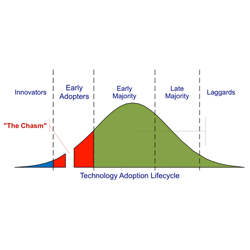You are fascinated by a painting you’ve discovered, and want to see more of the artist’s work. You’ve been pricing a new toy at Best Buy, but need to see which stores carry it in hot pink. You are walking past a billboard for the hippest band in town and want to add it to your digital calendar without skipping a beat. Maybe you’re even reading an article about QR codes on your laptop, and want to quickly take it with you and share with a friend. Manufacturers and marketers have been steadily dropping more of these blocky barcodes all around us, but do you know how to use them yet?

A QR code (quick response code) is a simple 2D barcode that holds 4 to 10 times the information compared to that of the standard barcode format. And while QR codes were first used for tracking inventories in Japan, the uses of this openly standardized barcode format have become almost limitless, especially in the marketing world. QR code readers are available for most every smartphone platform (for free), and with a simple point and snap with your phone’s camera, you can be transported to a URL to find out more about a new product or automatically add a colleague to your contacts list.
So if QR codes are so easy to use, and extremely useful to most anybody with a smartphone, why doesn’t everybody use them in their daily life? Simple, we haven’t crossed that chasm yet. In “Crossing the Chasm”, a marketing book by Geoffrey A. Moore, he describes 5 primary segments of technology adopters, each having their own traits, and each called to action by something different.  They adopt changes to the technology in their life at different rates, each segment building on top of the momentum created by previous segments. And while there is already huge value to using QR codes across the web, print, mobile and social mediums, we’re still very much in the early adopter phase. This is no different than the advent of CDs or the daily usage of Facebook. How long does it take you to switch over to what’s new, and how does that compare with others around you?
They adopt changes to the technology in their life at different rates, each segment building on top of the momentum created by previous segments. And while there is already huge value to using QR codes across the web, print, mobile and social mediums, we’re still very much in the early adopter phase. This is no different than the advent of CDs or the daily usage of Facebook. How long does it take you to switch over to what’s new, and how does that compare with others around you?
As a developer for interactive marketing agency Springbox, we most recently used them to announce our free holiday-themed wallpapers for mobile devices, and often pitch QR codes to clients who are looking for the coolest new way to connect with both new and existing customers, and quickly direct public interest to their campaign.
The good news is that QR code technology is simple to use, and it’s free! With free apps like ZXing’s Barcode Scanner for Android, Ricoh’s iCandyMobile for iPhone and iPod Touch, or BeeTagg for BlackBerry, there are few obstacles to being able to scan codes easily from a mobile device.
All of us can be consumers of QR codes, but there is a chasm between early adoption and the beginning of mainstream. This is where exponentially rapid adoption becomes a requirement to cross over to the Early Majority phase, or risk fizzling out. Barcodes are not human-readable, so they may appear difficult to use. But the action of snapping a QR code can save precious moments many, many times over. It’s the difference between the grocery clerk manually ringing up every item’s price on paper, or scanning your cart’s items using a sophisticated barcode and reader. And in the marketing world, fast engagement is key to staying relevant to the customer and improving conversion rates.
When users discover how they can create their own QR codes from major websites like Google’s ZXing project and Kaywa, or send them as coupons in their email newsletters using MailChimp, they will not only better understand what is available to them, but innovators will keep pushing the envelope with what the technology is capable. This is demonstrated simply by the evolution that has already occurred, where barcodes for scanning automobile parts have been repurposed for other industries and consumed by the general public on advertisements, hockey game programs, t-shirts, and not surprisingly, food.
So if you want to help take QR codes from “that’s cool” to “I gotta have it”, just start scanning!
Show your friends and your family what you’ve learned, and help them get a reader on their device so they can enjoy showing up early to the party this time.
Be a champion amongst your co-workers by suggesting some of the many business applications of 2D barcodes, and proving how much value QR codes create for your company and your customers.
